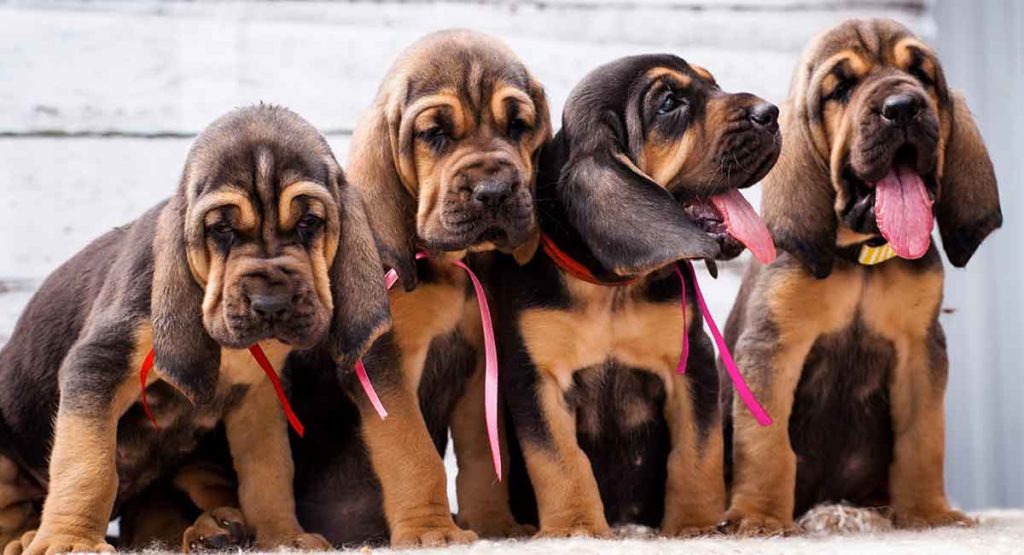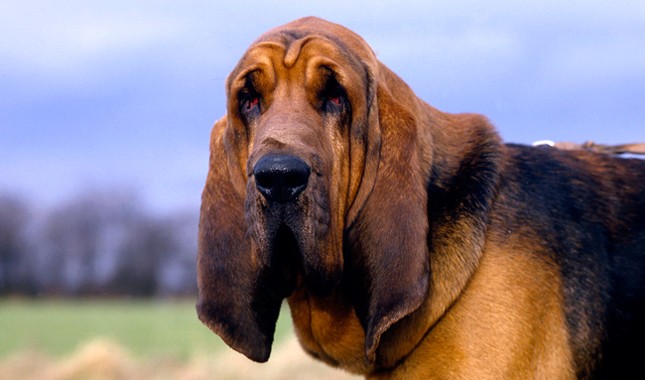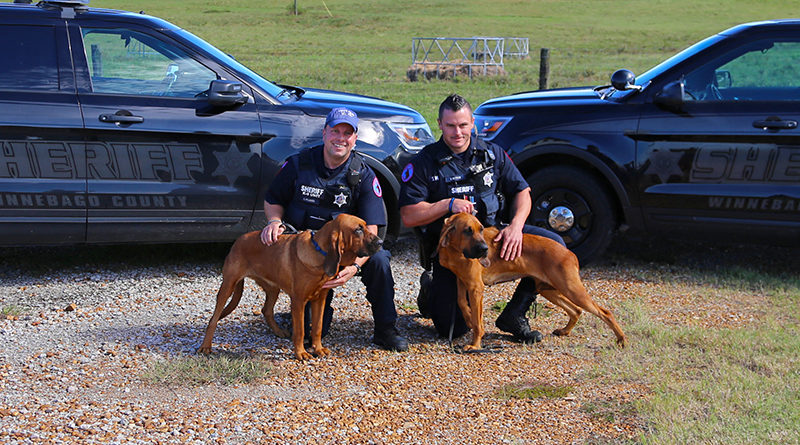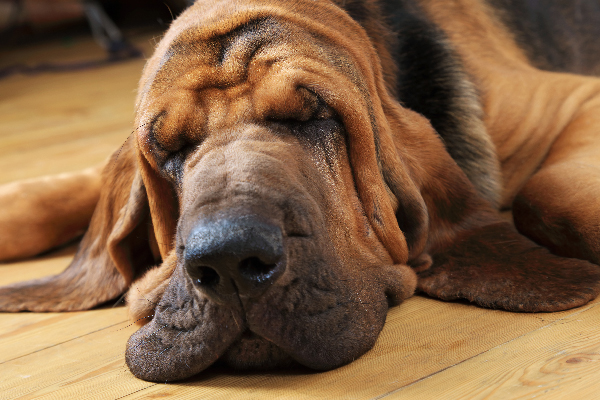Other names: Chien de Saint-Hubert, Saint Hubert Hound, Sleuth-hound or Limer / Limier.
The Bloodhound is a large scent-hound, originally bred for hunting deer, wild boar and, since the Middle Ages, for tracking people. Believed to be descended from hounds once kept at the Abbey of Saint-Hubert, Belgium, it is known to French speakers as le chien de Saint-Hubert. A more literal name in French for the bloodhound is le chien de sang.
This breed is famed for its ability to discern human scent over great distances, even days later. Its extraordinarily keen sense of smell is combined with a strong and tenacious tracking instinct, producing the ideal scent-hound, and it is used by police and law enforcement all over the world to track escaped prisoners, missing people, and lost pets.
Appearance

Bloodhounds weigh from 36 to 72 kg (80 to 160 lbs). They are 58 to 69 cm (23 to 27 inches) tall at the withers. Colours for bloodhounds are black, liver, tan, and red. Bloodhounds possess an unusually large skeletal structure with most of their weight concentrated in their bones, which are very thick for their length. The coat typical for a scent-hound is hard and composed of fur alone, with no admixture of hair.
Temperament
This breed is gentle and is tireless when following a scent. Because of its strong tracking instinct, it can be willful and somewhat difficult to obedience train and handle on a leash. Bloodhounds have an affectionate and even-tempered nature with humans, making them excellent family pets.
History
Chien de Saint-Hubert

The St. Hubert hound was, according to legend, first bred ca. 1000 AD by monks at the Saint-Hubert Monastery in Belgium; its likely origins are in France, home of many of modern hounds. It is held to be the ancestor of several other breeds, like the extinct Norman hound, and Saintongeois, and the modern Grand Bleu de Gascogne, Gascon Saintongeois, Ariegeois and Artois Normande, as well as the bloodhound. It has been suggested that it was a dog of mixed breeding, not at all uniform in type.
Whether they originated there, or what their ancestry was, is uncertain, but from ca. 1200, the monks of the Abbey of St Hubert annually sent several pairs of black hounds as a gift to the King of France. They were not always highly thought of in the royal pack. Charles IX 1550–74, preferred his white hounds and the larger Chiens-Gris, and wrote that the St Huberts were suitable for people with gout to follow, but not for those who wished to shorten the life of the hunted animal. He described them as pack-hounds of medium stature, long in the body, not well sprung in the rib, and of no great strength. Writing in 1561 Jaques du Fouilloux describes them as strong of body, but with low, short legs. He says they have become mixed in breeding so that they are now of all colours and widely distributed. Charles described the ‘true race’ of St Hubert as black, with red/tawny marks above the eyes and legs usually of the same colour, suggesting a ‘blanket’ black and tan (see Section on Colour types above). To De Fouilloux the ‘pure black’ were the best of this mixed breed. Both writers thought them only useful as leash hounds. They both refer to a white hound, also a St Hubert, which by their time had disappeared, having been interbred with another white hound, the greffier, to produce the king’s preferred pack hound, sometimes called le chien blanc du roi, “the white dog of the king”.
They appear to have been more highly thought of during the reign of Henry IV (1553–1610), who presented a pack to James I of England. By the end of the reign of Louis XIV (1715), they were already rare. In 1788, D’Yauville, who was master of the Royal hounds, says those sent by the St Hubert monks, once much prized, had degenerated, and scarcely one of the annual gifts of six or eight was kept.
Upon the French Revolution of 1789, the gifts ceased, and hunting in France went into a decline until the end of the Napoleonic wars. When it recovered during the 19th Century, huntsmen, with many breeds to choose from, seem to have had little interest in St Hubert. An exception was Baron Le Couteulx de Canteleu, who tried to find them. He reported that there were hardly any in France, and those in the Ardennes were so cross-bred that they had lost the characteristics of the breed.
Writers on the bloodhound in the last two centuries generally agreed that the original St Hubert strain died out in the nineteenth century and that the European St Hubert owes its present existence to the development of the Bloodhound.
Bloodhound

References to bloodhounds first appear in English writing in the early to mid 14th century, in contexts that suggest the breed was well established by then. It is often claimed that its ancestors were brought over from Normandy by William the Conqueror, but there is no actual evidence for this. That the Normans brought hounds from Europe during the post-Conquest period is virtually certain, but whether they included the Bloodhound itself, rather than merely its ancestors, is a matter of dispute that probably cannot be resolved based on surviving evidence.
In Medieval hunting, the typical use of the Bloodhound was as a ‘limer’, or ‘lyam-hound’, that is a dog handled on a leash or ‘lyam’, to find the hart or boar before it was hunted by the pack hounds (raches). It was prized for its ability to hunt the cold scent of an individual animal, and, though it did not usually take part in the kill, it was given a special reward from the carcass.
It also seems that from the earliest times the Bloodhound was used to track people. There are stories written in Medieval Scotland of Robert the Bruce (in 1307), and William Wallace (1270–1305) being followed by ‘sleuth hounds’. Whether true or not, these stories show that the sleuth-hound was already known as a man-trailer, and it later becomes clear that the sleuth-hound and the Bloodhound were the same animals.
In the 16th century, John Caius, in the most important single source in the history of the Bloodhound, describes its hanging ears and lips, its use in-game parks to follow the scent of blood, which gives it its name, its ability to track thieves and poachers by their foot scent, how it casts if it has lost the scent when thieves cross water, and its use on the Scottish borders to track cross-border raiders, known as Border Reivers. This links it to the sleuth-hound, and from Caius also comes the information that the English Bloodhound and the sleuth-hound were essentially the same, though the Bloodhound was slightly bigger, with more variation in coat colour.
The adjacent picture was published in Zurich in 1563, in Conrad Gesner’s Thierbuch (a compendium of animals) with the captions: ‘Englischen Blüthund’ and ‘Canis Sagax Sanguinarius apud Anglos’ (English scent-hound with associations of blood). It was drawn by, or under the supervision of, John Caius, and sent to Gesner with other drawings to illustrate his descriptions of British dogs for European readers. It is thus the earliest known picture published specifically to demonstrate the appearance of the Bloodhound. We are told it was done from life, and detail such as the soft hang of the ear indicates it was carefully observed. Fully accurate or not, it suggests changes between the Bloodhound of then and today. The collar and long coiled rope reflect the Bloodhound’s typical functions as a limer or leashed man-trailer in that period.
The earliest known report of a trial of the Bloodhound’s trailing abilities comes from the scientist Robert Boyle, who described how a Bloodhound tracked a man seven miles along a route frequented by people and found him in an upstairs room of a house.
With the rise of fox-hunting, the decline of deer-hunting, and the extinction of the wild boar, as well as a more settled state of society, the use of the Bloodhound diminished. It was kept by the aristocratic owners of a few deer-parks and by a few enthusiasts, with some variation in type until its popularity began to increase again with the rise of dog-showing in the 19th Century. Numbers, however, have remained low in Britain. Very few survived the Second World War, but the gene-pool has gradually been replenished with imports from America. Nevertheless, because of UK quarantine restrictions, importing was expensive and difficult, throughout the 20th century, and in the post-war period exports to the US, and to Europe where the population had also been affected by the war, considerably exceeded imports.
During the later 19th century, numbers of Bloodhounds were imported from Britain by French enthusiasts, who regretted the extinction of the ancient St Hubert. They wished to re-establish it, using the Bloodhound, which, despite its developments in Britain, they regarded as St Hubert preserved unchanged. Many of the finest specimens were bought and exhibited and bred in France as Chiens de S. Hubert, especially by Le Couteulx de Canteleu, who himself bred over 300. Whatever few original St Huberts remained either died out or were absorbed into the new population. As a result, the Bloodhound became known on parts of the Continent as the Chien de Saint-Hubert. In the mid 20th century the Brussels-based FCI accepted the claim of Belgium to be the country of origin. There are now annual celebrations in the town of Saint-Hubert, in which handlers in period dress parade their hounds. In Britain, the bloodhound has continued to be seen as a native breed, with European St Huberts being accepted by the UK KC as bloodhounds.
In Le Couteulx’ book of 1890, we read that ‘Le Chien de St Hubert actuel’ is very big, from 0m,69 to 0m,80 (27½-31½in) high. This does not accord with the 16th-century descriptions of St Hubert given above, nor with the FCI standard, but the idea that St Hubert is much bigger (up to 91.5 cm, 36 in) than the Bloodhound persisted well into the 20th century, among some St Hubert enthusiasts.
When the first Bloodhounds were exported to the USA is not known. Bloodhounds were used to track runaway slaves before the American Civil War, but it has been questioned whether the dogs used were genuine Bloodhounds. However, in the latter part of the 19th century, and the next, more pure Bloodhounds were introduced from Britain, and bred in America, especially after 1888, when the English breeder, Edwin Brough, brought three of his hounds to exhibit at the Westminster KC show in New York City. He went into partnership with Mr J L Winchell, who with other Americans, imported more stock from Britain. Bloodhounds in America have been more widely used in tracking lost people and criminals – often with brilliant success – than in Britain, and the history of the Bloodhound in America is full of the man-trailing exploits of outstanding Bloodhounds and their expert handlers, the most famous hound being Nick Carter. Law enforcement agencies have been much involved in the use of Bloodhounds, and there is a National Police Bloodhound Association, originating in 1962.
In Britain, there have been instances from time to time of the successful use of the Bloodhound to track criminals or missing people. However man-trailing is enjoyed as a sport by British Bloodhound owners, through national working trials, and this enthusiasm has spread to Europe. Also, while the pure Bloodhound is used to hunt singly, bloodhound packs use bloodhounds crossed with foxhounds to hunt the human scent.
Meanwhile, the Bloodhound has become widely distributed internationally, though numbers are small in most countries, with more in the USA than anywhere else. Following the spread of the Bloodhound from Britain in the nineteenth and twentieth centuries, imports and exports and, increasingly, artificial insemination, are maintaining the world population as common breeding stock, without a great deal of divergence in type in different countries.
During the late 19th century, Bloodhounds were frequent subjects for artists such as Edwin Landseer and Briton Riviere; the dogs depicted are close in appearance to modern Bloodhounds, indicating that the essential character of the Bloodhound predates modern dog breeding. However, the dogs depicted by Landseer show less wrinkle and haw than modern dogs.
